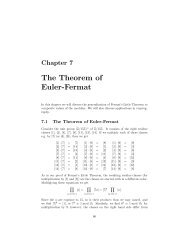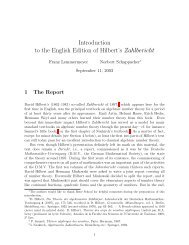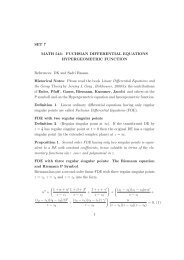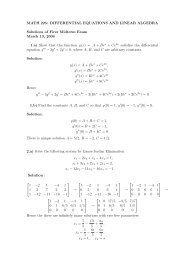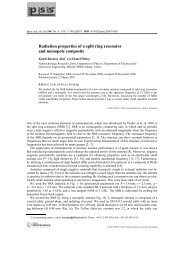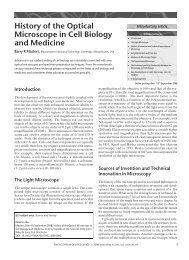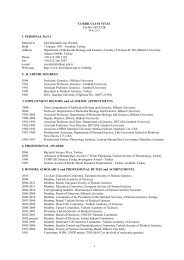Correlation of histology and linear and nonlinear microscopy of the ...
Correlation of histology and linear and nonlinear microscopy of the ...
Correlation of histology and linear and nonlinear microscopy of the ...
Create successful ePaper yourself
Turn your PDF publications into a flip-book with our unique Google optimized e-Paper software.
Journal <strong>of</strong><br />
BIOPHOTONICS<br />
134<br />
B. R. Masters: <strong>Correlation</strong> <strong>of</strong> <strong>histology</strong> <strong>and</strong> <strong>linear</strong> <strong>and</strong> non<strong>linear</strong> <strong>microscopy</strong> <strong>of</strong> <strong>the</strong> living human cornea<br />
harmonic generation (SHG) an incident wave <strong>of</strong> frequency<br />
w generates a new signal at <strong>the</strong> frequency<br />
2w. With <strong>the</strong> proper conditions <strong>the</strong> efficiency <strong>of</strong> this<br />
process can exceed 50 percent. SHG can only occur<br />
in media that does not contain inversion symmetry<br />
because all even-order non<strong>linear</strong> susceptibilities are<br />
zero in centrosymmetric media.<br />
SHG <strong>and</strong> third-harmonic generation (THG) can<br />
be explained by <strong>the</strong> <strong>the</strong>ory <strong>of</strong> <strong>the</strong> non<strong>linear</strong> susceptibility<br />
in which for <strong>the</strong> time domain <strong>the</strong> polarization<br />
is exp<strong>and</strong>ed in a power series <strong>of</strong> <strong>the</strong> sum <strong>of</strong> products<br />
<strong>of</strong> <strong>the</strong> <strong>linear</strong> susceptibility <strong>and</strong> <strong>the</strong> electric field, <strong>the</strong><br />
second-order susceptibility <strong>and</strong> <strong>the</strong> square <strong>of</strong> <strong>the</strong><br />
electric field, <strong>and</strong> <strong>the</strong> third-order susceptibility <strong>and</strong><br />
<strong>the</strong> cube <strong>of</strong> <strong>the</strong> electric field <strong>and</strong> higher-order terms.<br />
SHG is described by <strong>the</strong> second-order susceptibility,<br />
<strong>and</strong> THG is described by <strong>the</strong> third-order susceptibility<br />
[47]. The complete <strong>the</strong>oretical description <strong>of</strong><br />
SHG <strong>and</strong> THG requires that <strong>the</strong> polarization <strong>and</strong><br />
<strong>the</strong> vector properties <strong>of</strong> <strong>the</strong> electromagnetic field be<br />
accounted for in <strong>the</strong> analysis.<br />
THG has a broad potential for tissue imaging<br />
since it occurs in all materials, including dielectric<br />
materials with inversion symmetry [48]. In general<br />
THG is a weak process; however, it is dipole allowed.<br />
It occurs at all interfaces free from <strong>the</strong> constraint<br />
<strong>of</strong> phase-matching. Third-harmonic generation<br />
<strong>microscopy</strong> has a large potential for cell <strong>and</strong><br />
tissue imaging. As new techniques are developed for<br />
<strong>the</strong> surface-enhanced THG at interfaces <strong>the</strong> technique<br />
may become useful for imaging <strong>the</strong> cornea.<br />
SHG <strong>microscopy</strong> in tissues can be used to image<br />
microtubles, oriented protein structures <strong>and</strong> stacked<br />
membranes [49–51]. Ano<strong>the</strong>r emerging development<br />
is <strong>the</strong> use <strong>of</strong> THG <strong>microscopy</strong> with nano-gold<br />
particles to utilize <strong>the</strong> surface-plasmon-resonance effect<br />
[52].<br />
Both SHG <strong>and</strong> THG imaging do not exhibit <strong>the</strong><br />
saturation effects or <strong>the</strong> photobleaching effects that<br />
are associated with multiphoton excitation fluorescence<br />
<strong>microscopy</strong>. Therefore, SHG <strong>and</strong> THG <strong>microscopy</strong><br />
do not require ei<strong>the</strong>r intrinsic nor extrinsic<br />
fluorescent probes. These microscopic techniques<br />
can penetrate into millimeters <strong>of</strong> tissue <strong>and</strong> provide<br />
sub-micron three-dimensional optical sectioning.<br />
3.3 Review <strong>of</strong> some key applications with<br />
non<strong>linear</strong> optical <strong>microscopy</strong> <strong>of</strong> <strong>the</strong> cornea<br />
In ano<strong>the</strong>r investigation, <strong>the</strong> structure <strong>of</strong> <strong>the</strong> ex vivo<br />
rabbit cornea was studied with a multiphoton microscope<br />
that employed both SGH imaging <strong>and</strong> twophoton<br />
excited fluorescence (TPF) in a back scattering<br />
geometry [53]. Endogenous TPF <strong>and</strong> SHG signals<br />
from corneal cells <strong>and</strong> <strong>the</strong> extracellular matrix, re-<br />
spectively, were observed without exogenous dyes.<br />
The polarization dependence <strong>of</strong> <strong>the</strong> collagen SHG<br />
was used to study fiber orientation in <strong>the</strong> cornea. The<br />
authors demonstrated <strong>the</strong> spectra <strong>of</strong> <strong>the</strong> TPF fluorescence<br />
signal as well as <strong>the</strong> SHG signal in <strong>the</strong> collagen<br />
matrix <strong>of</strong> <strong>the</strong> cornea. The SHG signal had a quadratic<br />
dependence on <strong>the</strong> incident laser power. The<br />
authors compared <strong>the</strong> images from <strong>the</strong> TPF <strong>and</strong> <strong>the</strong><br />
SHG modes with Hematoxylin <strong>and</strong> Eosin (H & E<br />
stain) stained en face formalin-fixed sections <strong>of</strong> <strong>the</strong><br />
corneal stroma. Thus, <strong>the</strong>y demonstrated <strong>the</strong> utility<br />
<strong>of</strong> correlative <strong>microscopy</strong> to interpret <strong>the</strong> images.<br />
Histology is fixed, stained tissue specimens is a useful<br />
comparison for optical imaging; however, <strong>the</strong> user<br />
should be cautious <strong>and</strong> knowledgeable about <strong>the</strong> artifacts<br />
<strong>of</strong> <strong>histology</strong> such as tissue shrinkage.<br />
Ano<strong>the</strong>r study <strong>of</strong> corneal pathology in a transgenic<br />
mouse model shows <strong>the</strong> importance <strong>of</strong> measuring<br />
<strong>the</strong> emission spectra <strong>of</strong> <strong>the</strong> cornea to validate <strong>the</strong><br />
interpretation <strong>of</strong> <strong>the</strong> non<strong>linear</strong> <strong>microscopy</strong> [54]. The<br />
authors used non<strong>linear</strong> optical <strong>microscopy</strong> (two<br />
photon excited fluorescence, <strong>and</strong> second harmonic<br />
generation signals) to image <strong>the</strong> corneas <strong>of</strong> a transgenic<br />
mouse model. Images were presented <strong>of</strong> <strong>the</strong><br />
combined non<strong>linear</strong> signals from <strong>the</strong> cornea that<br />
consisted <strong>of</strong> TPF <strong>and</strong> SHG combined signals. To validate<br />
<strong>the</strong> images, H & E stained sections <strong>of</strong> <strong>the</strong> transgenic<br />
mouse cornea were presented. Metabolic activity<br />
in both <strong>the</strong> epi<strong>the</strong>lial (<strong>the</strong> authors did not specify<br />
which cell layer <strong>of</strong> <strong>the</strong> epi<strong>the</strong>lium was imaged) <strong>and</strong><br />
<strong>the</strong> endo<strong>the</strong>lial cellular layers were imaged by co-localizing<br />
<strong>the</strong> reduced pyridine nucleotide, NAD(P)H<br />
images <strong>and</strong> <strong>the</strong> flavin adenine dinucleotide (FAD)<br />
images in different colors. The authors also presented<br />
emission spectra for NAD(P)H <strong>and</strong> FAD in<br />
both <strong>the</strong> corneal epi<strong>the</strong>lial <strong>and</strong> endo<strong>the</strong>lial layers <strong>of</strong><br />
<strong>the</strong> transgenic mouse. Unfortunately, <strong>the</strong> emission<br />
spectra were not corrected for <strong>the</strong> instrument response.<br />
Second-harmonic generation <strong>microscopy</strong> is ano<strong>the</strong>r<br />
emerging area <strong>of</strong> non<strong>linear</strong> <strong>microscopy</strong> that is<br />
being applied to <strong>the</strong> cornea. SHG imaging <strong>of</strong> <strong>the</strong> excused<br />
porcine cornea after intrastromal femtosecond<br />
laser ablation was investigated to evaluate <strong>the</strong> next<br />
generation <strong>of</strong> laser surgical techniques [55]. This is<br />
an important approach since NIR fs laser surgery<br />
avoids <strong>the</strong> risks <strong>of</strong> mutagenicity <strong>and</strong> toxicity that accompanies<br />
<strong>the</strong> UV radiation <strong>of</strong> excimer lasers. Collagen<br />
has a noncentrosymmetric structure <strong>and</strong> can<br />
convert <strong>the</strong> incident ultrashort laser pulse to its second<br />
harmonic, thus providing a noninvasive imaging<br />
modality for <strong>the</strong> cornea. Since <strong>the</strong> SHG signal from<br />
<strong>the</strong> collagen in <strong>the</strong> cornea is emitted predominately<br />
in <strong>the</strong> forward direction (<strong>the</strong>re was only a very weak<br />
signal in <strong>the</strong> back scattered path), it was detected in<br />
<strong>the</strong> transmission mode. The authors demonstrated<br />
that <strong>the</strong> SHG signal is proportional to <strong>the</strong> second<br />
power <strong>of</strong> <strong>the</strong> normalized illumination intensity. High<br />
# 2009 by WILEY-VCH Verlag GmbH & Co. KGaA, Weinheim www.biophotonics-journal.org



